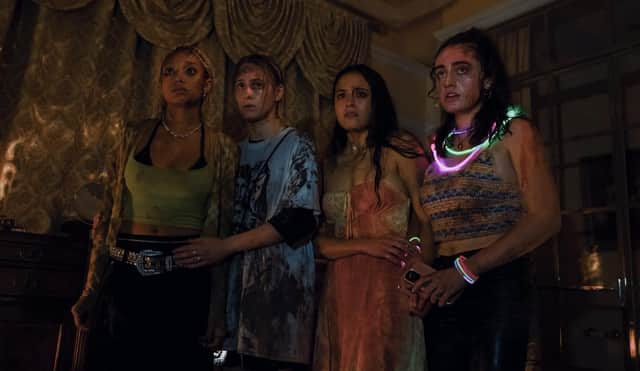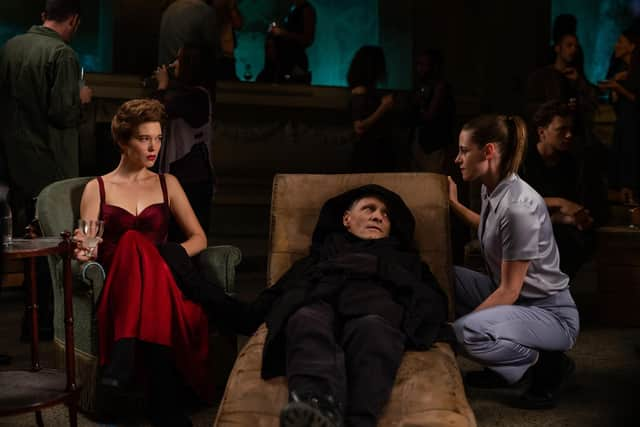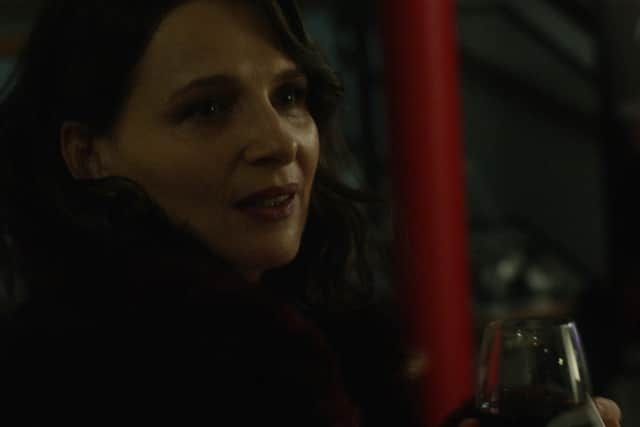Film reviews: Bodies Bodies Bodies | Crimes of the Future | Both Sides of the Blade | Pinocchio | See How They Run | Tad the Lost Explorer | Ride the Wave


Bodies Bodies Bodies (15) ****
Crimes of the Future (18) ****
Both Sides of the Blade (15) ****
Pinocchio (9+) ***
See How They Run (12A) ***
Tad the Lost Explorer and The Curse of the Mummy (U) **
Ride the Wave (12A) ****


Named for a party game explained early in the film, Bodies Bodies Bodies puts a deliciously sly twist on slasher movie conventions by using them to skewer the self-curated pretensions of its narcissistic Gen-Z protagonists. The Hate U Give’s Amandla Stenberg and Maria Baklava (the break-out star of Borat Subsequent Movie Film) take the ostensible leads as Sophie and Bee, a newly-in-love couple whose arrival at the mansion of Sophie’s childhood best friend David (Pete Davidson) for a party disrupts the already debauched dynamic of a group of long-time friends as they ready themselves for a night of drunken, coked-up fun.
Set against the backdrop of an imminent hurricane, the film takes its time introducing us to the assembled group, a stylistic choice that gives the performances room to breath, especially Davidson’s, whose obnoxious turn as David drives the early part of the film. This also allows Dutch director Halina Reijn to drip-feed details about Sophie’s backstory while expertly establishing red herrings that ratchet up the film’s effectiveness when the titular game turns literal.
Advertisement
Hide AdOnce the power fails and the bodies start piling up, Reijn uses the glow of the characters’ smart phones to spotlight the fear, paranoia and viciousness lurking beneath the characters’ perfectly presented exteriors as they turn on each other faster than a triggered Twitter mob. This is no mundane elevated horror, though. Its status as a social media metaphor is perfectly integrated into a gory, funny, fiendishly clever plot with an audaciously outré twist-ending to boot.
Bodies, bodies, bodies are also very much on the mind of David Cronenberg in his latest Crimes of the Future. His first film for eight years works as a spiritual sequel to cult classics Videodrome and eXistenZ by positing an alternate reality in which technology and human flesh are evolving as one, mutating the species in ways that are scary, strange and sensual. Cronenberg regular Viggo Mortensen stars as Saul Tenser, something of a celebrity in the culturally predominant world of performance art that dominates a new society where humans no longer feel pain, “surgery is the new sex” and porn takes the form of live medical procedures gawped at by well-to-do sickos who get off on watching scalpels slice skin or remove the new organs that some people (Saul among them) seem to be growing at an alarming rate.


Whether or not these mutations are evolutionary responses to a toxic world is the big question the film is grappling with, but Cronenberg buries the theme in a noirish subplot involving a murdered child with freaky ability to digest plastic. Almost more interesting, though, is his conjuring of a world in which our private lives have been so mined and exploited for entertainment that the only currency we have left is literally what’s growing inside us – an idea he takes to enjoyably icky extremes. Léa Seydoux, Kristen Stewart and Scott Speedman co-star.
After her Cronenbergian sci-fi outing High Life, Claire Denis’ latest offers sensuousness without the transgressive sexual flourishes found in that movie. Indeed, Both Sides of the Blade feels more like a throwback to her magnificent 2002 feature Vendredi Soir, only instead of exploring the onset of a swooning relationship she looks at how one falls apart. Sara and Jean (Juliette Binoche and Vincent Lidon) are the couple in question, and while a wordless five-minute opening sequence captures the Edenic perfection of their lives as they enjoy a break from Paris, their relationship is doomed the moment they return home and Sara catches sight of François (Grégoire Colin), an old flame and Jean’s former best friend. What follows is layered, tactile drama fuelled by an emotionally devastating Binoche as a woman unable to stop herself falling back into old patterns.
With Pinocchio, Disney delivers another “live action” remake of one of its animation classics, with Tom Hanks as Geppetto and Hanks’s Forrest Gump/Polar Express director Robert Zemeckis pulling the strings of a CGI Pinocchio. The new film follows the original Disney version fairly faithfully, albeit with some additional songs and more amped-up action. As with the first version, the nose-growing remains a surprisingly small part of the story while the Pleasure Island sequence is as odd and discomfiting as it was the first time. Elsewhere, this is as saccharine as you might expect, though Cynthia Erivo is fun as the Blue Fairy.
Following the success of Knives Out and Kenneth Branagh’s recent big screen Poirot adaptations, the appetite for Agatha Christie-stye whodunits shows no sign of diminishing. The latest is See How They Run, a sort of meta-adaptation of Christie’s long-running London West End hit The Mousetrap set against the backdrop of its 100th performance, with the murder of a movie director (Adrien Brody) working on a film version inevitably echoing the events of the play. An English-accented Sam Rockwell and Saoirse Ronan star as the weary detective and bright-spark police constable reluctantly partnered up to examine the crime; meanwhile Harris Dickinson (as original cast member Dickie Attenborough) leads a supporting cast of real and fictional characters caught up in the investigation. Though the film mistakes acknowledging the tropes of a genre for subverting them, it’s entertainingly performed and offers the same hit of nostalgia modern audiences get from The Mousetrap.
Advertisement
Hide AdThe Spanish-produced animated adventure film Tad the Lost Explorer and The Curse of the Mummy is the third film in this Indian Jones-inspired franchise and perhaps over-estimates its target audience’s familiarity with its own predecessors. More dispiriting is that that the series makes a hero out of a bumbling amateur archeologist while demonising anyone with any smarts. Tad’s goofy mummy side-kick raises the odd smile, though.
“Big-wave riding’s for macho assholes with a death wish,” scorned Lori Petty in Point Break. Not so according to the moving new Scottish surfing documentary Ride the Wave. Following Tiree-based teenage surfing prodigy Ben Larg as he transitions from global surfing competitions for under-18s to tackling formidable-looking breaks off the coast of Ireland, Martyn Robertson’s film is admirably devoid of testosterone, focussing instead on how this quiet, thoughtful, relentlessly bullied kid comes into his own on the water. It’s also a film about Ben’s parents, and Robertson does a good job of exploring the often heart-rending decisions they’ve had to make to support him. Which isn’t to say there aren’t gnarly wipe-outs and Rocky-style training sessions. But having followed Ben and his loving family for four years, Robertson has a bigger story to tell, one that adds nuance and humanity to the driven outsider archetype beloved of sports movie narratives.
Advertisement
Hide AdBodies Bodies Bodies, Crimes of the Future, See How They Run, Tad the Lost Explorer and The Curse of the Mummy and Ride the Wave are in cinemas now; Both Sides of the Blade is on selected release and on Curzon Home Cinema; Pinocchio is streaming on Disney+